By Zhang Zhou Source:GMW.cn 2022-10-16
Since the 18th CPC National Congress, following the concept of innovation, coordination, green development, openness and sharing, China has expanded the scale of its construction industry and optimized its structure and regional layout. Over the past decade, the industry has not only provided a great number of jobs, its role as a pillar industry has also been consolidated, contributing enormously to socio-economic development and livelihood improving. Today, China is transforming itself from a big country of manufacturing into a strong power in manufacturing.
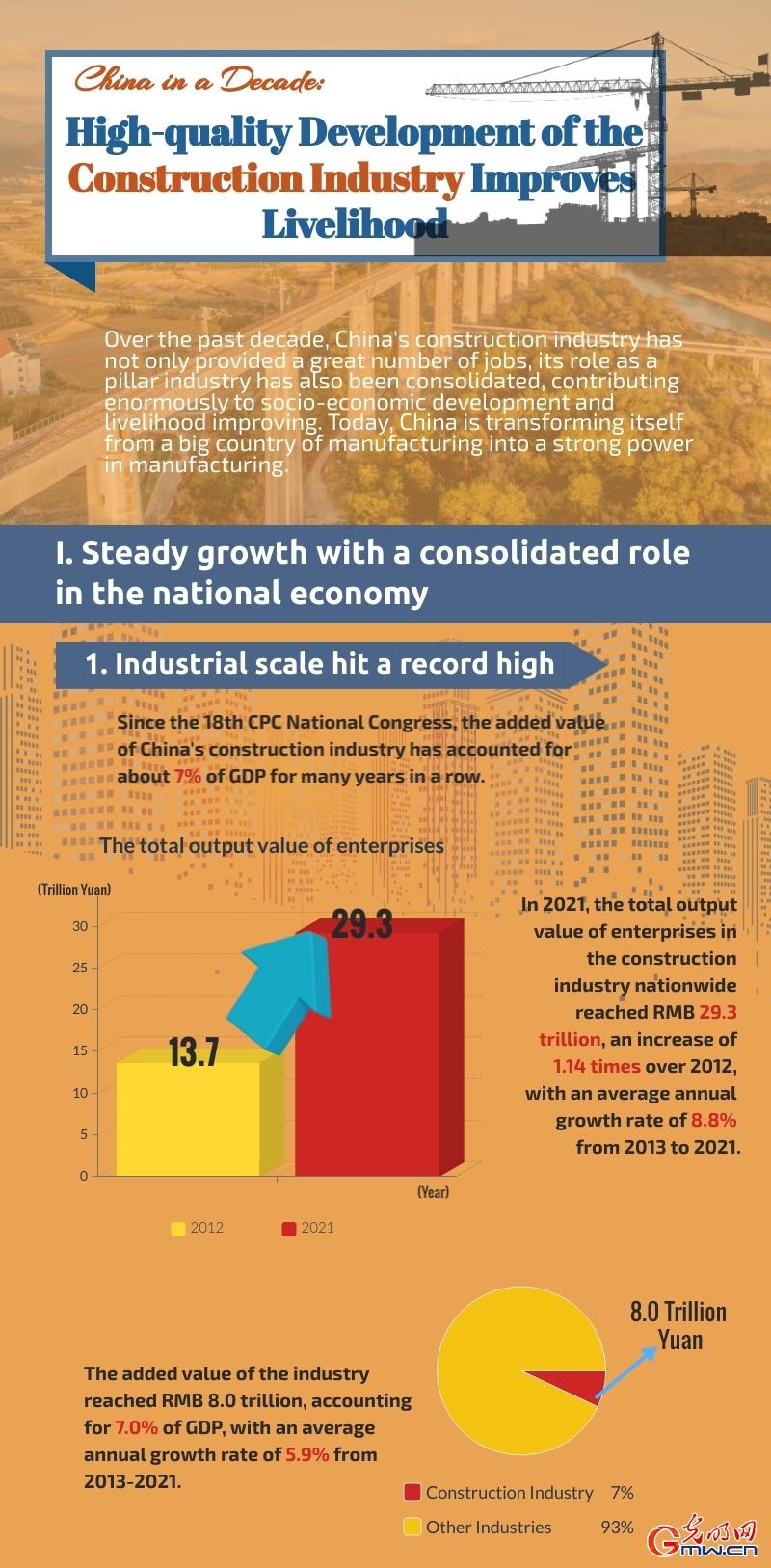
I. Steady growth with a consolidated role in the national economy
1. Industrial scale hit a record high
Since the 18th CPC National Congress, China’s construction industry has actively responded to the challenges and risks from both at home and abroad, withstood the impact of Covid-19 and achieved steady and healthy development. The added value of the industry has accounted for about 7% of GDP for many years in a row, and its role as the pillar of the national economy has remained stable.
In 2021, the total output value of enterprises in the construction industry nationwide reached RMB 29.3 trillion, an increase of 1.14 times over 2012, with an average annual growth rate of 8.8% from 2013 to 2021.
The added value of the industry reached RMB 8.0 trillion, accounting for 7.0% of GDP, with an average annual growth rate of 5.9% from 2013-2021.
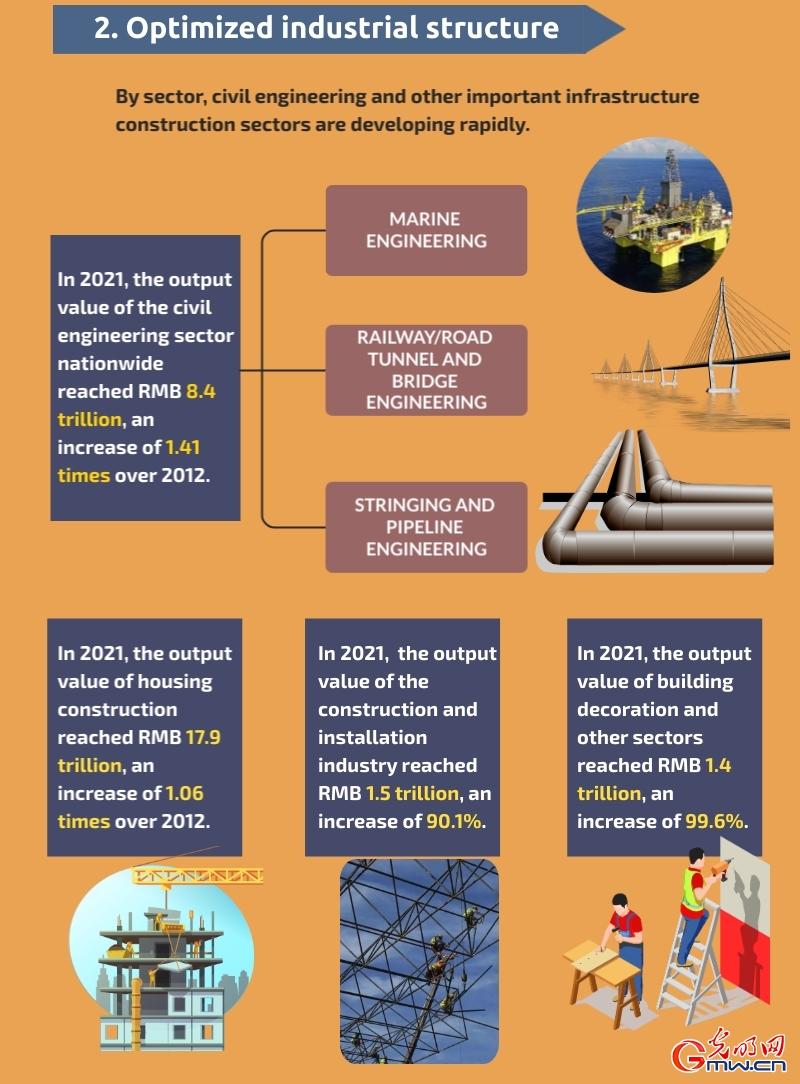
2. Optimized industrial structure
By sector, civil engineering and other important infrastructure construction sectors are developing rapidly.
In 2021, the output value of the civil engineering sector nationwide reached RMB 8.4 trillion, an increase of 1.41 times over 2012, of which the output value of marine engineering, railway/road tunnel and bridge engineering, and stringing and pipeline engineering had doubled, growing by 4.09 times, 1.59 times and 1.21 times respectively over 2012, contributing significantly to China’s infrastructure construction.
In 2021, the output value of housing construction reached RMB 17.9 trillion, an increase of 1.06 times over 2012; the output value of the construction and installation industry reached RMB 1.5 trillion, an increase of 90.1%; and the output value of building decoration and other sectors reached RMB 1.4 trillion, an increase of 99.6%.
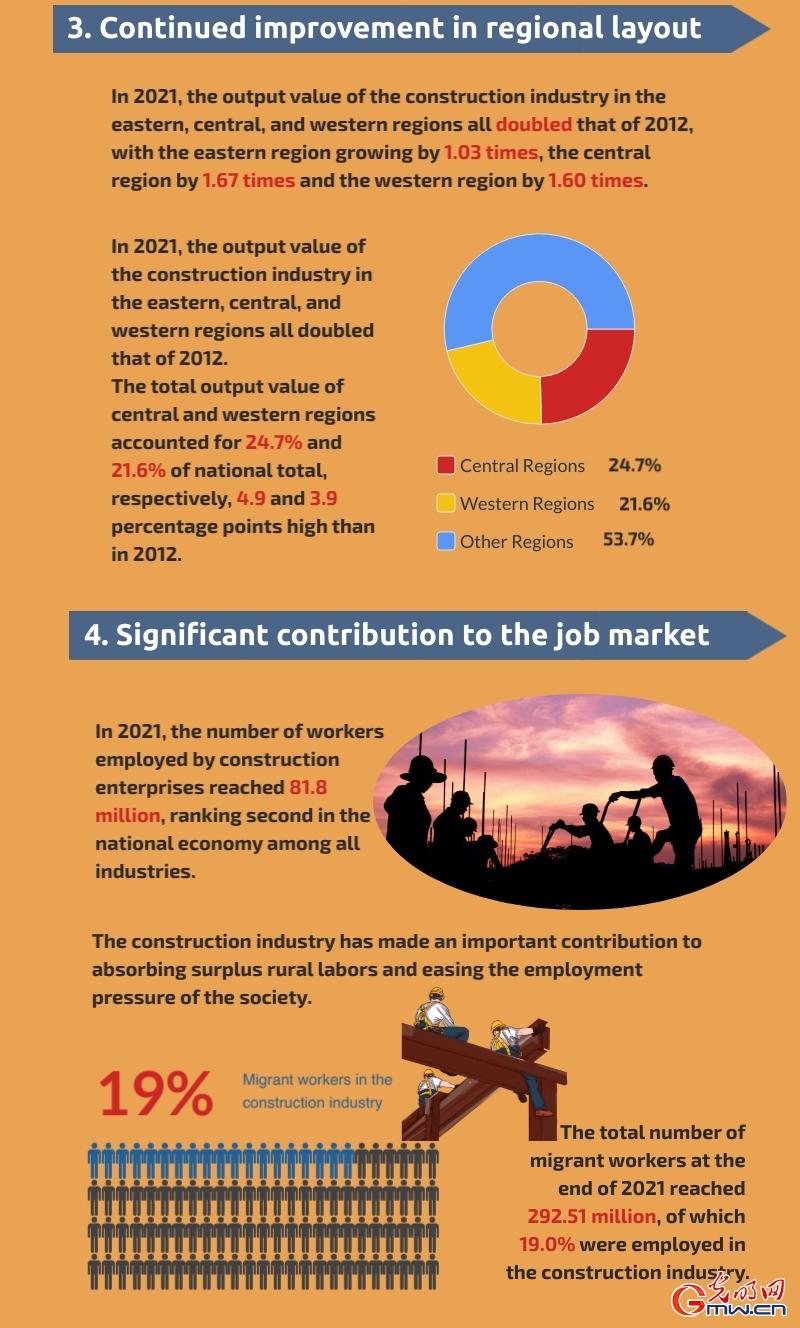
3. Continued improvement in regional layout
In 2021, the output value of the construction industry in the eastern, central, and western regions all doubled that of 2012, with the eastern region growing by 1.03 times, the central region by 1.67 times and the western region by 1.60 times. The total output value of central and western regions accounted for 24.7% and 21.6% of national total, respectively, 4.9 and 3.9 percentage points high than in 2012. The central and western regions show an obvious late-mover advantage, and development between regions is becoming more balanced.
4. Significant contribution to the job market
In 2021, the number of workers employed by construction enterprises reached 81.8 million, ranking second in the national economy among all industries. Among them, the average number of workers employed by construction enterprises with EPC and professional contracting qualifications reached 61.94 million, an increase of 33.8% over 2012 with an average annual growth of 3.3% from 2013 to 2021.
The construction industry has made an important contribution to absorbing surplus rural labors and easing the employment pressure of the society. According to the monitoring report of the National Bureau of Statistics, the total number of migrant workers at the end of 2021 reached 292.51 million, of which 19.0% were employed in the construction industry.
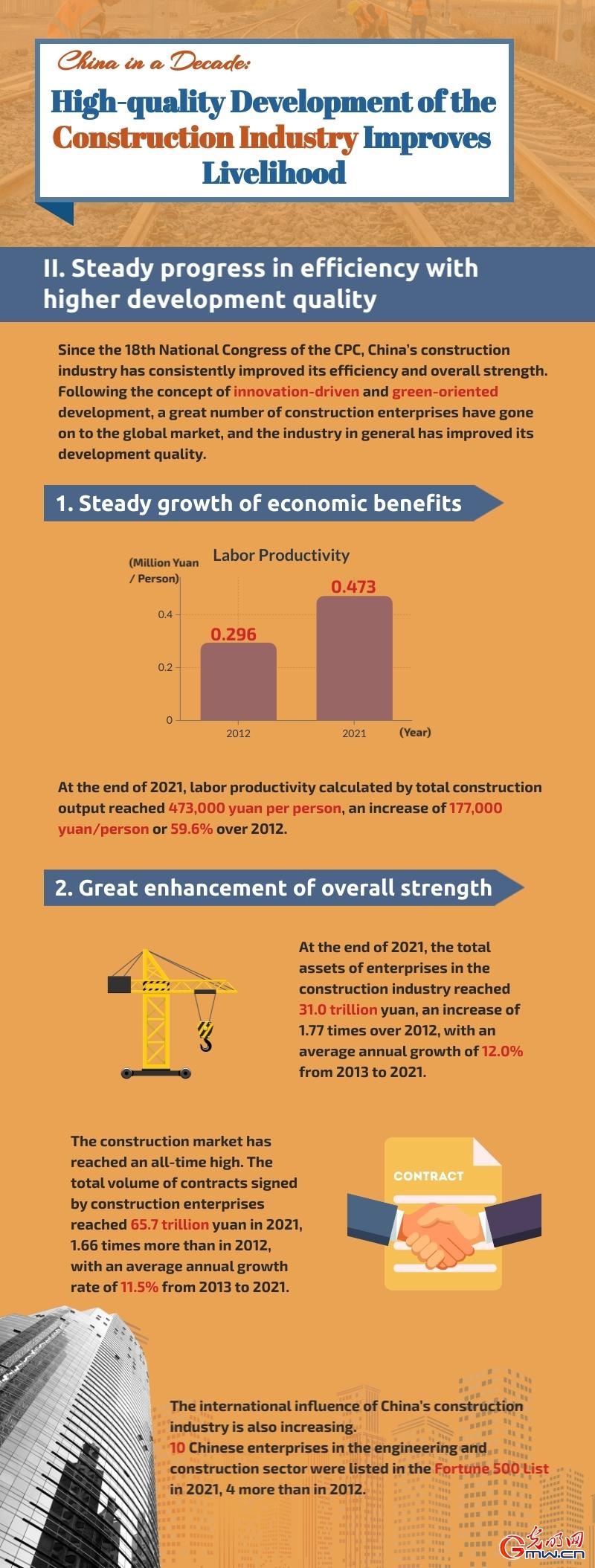
II. Steady progress in efficiency with higher development quality
Since the 18th National Congress of the CPC, China’s construction industry has consistently improved its efficiency and overall strength. Following the concept of innovation-driven and green-oriented development, a great number of construction enterprises have gone on to the global market, and the industry in general has improved its development quality.
1. Steady growth of economic benefits
At the end of 2021, labor productivity calculated by total construction output reached 473,000 yuan per person, an increase of 177,000 yuan/person or 59.6% over 2012.
The increase in productivity further boosted the profitability of enterprises, with both the operating income and profits growing at a faster pace.
In 2021, construction enterprises in China achieved a total business income of 27.0 trillion yuan, an increase of 1.07 times over 2012, with an average annual growth of 8.4% from 2013 to 2021; their total profit hit 855.4 billion yuan, an increase of 79.1% over 2012, with an average annual growth of 6.7% from 2013 to 2021.
2. Great enhancement of overall strength
The financial standing of enterprises is consolidated. At the end of 2021, the total assets of enterprises in the construction industry reached 31.0 trillion yuan, an increase of 1.77 times over 2012, with an average annual growth of 12.0% from 2013 to 2021.
The construction market has reached an all-time high. The total volume of contracts signed by construction enterprises reached 65.7 trillion yuan in 2021, 1.66 times more than in 2012, with an average annual growth rate of 11.5% from 2013 to 2021.
The international influence of China’s construction industry is also increasing. 10 Chinese enterprises in the engineering and construction sector were listed in the Fortune 500 List in 2021, 4 more than in 2012.
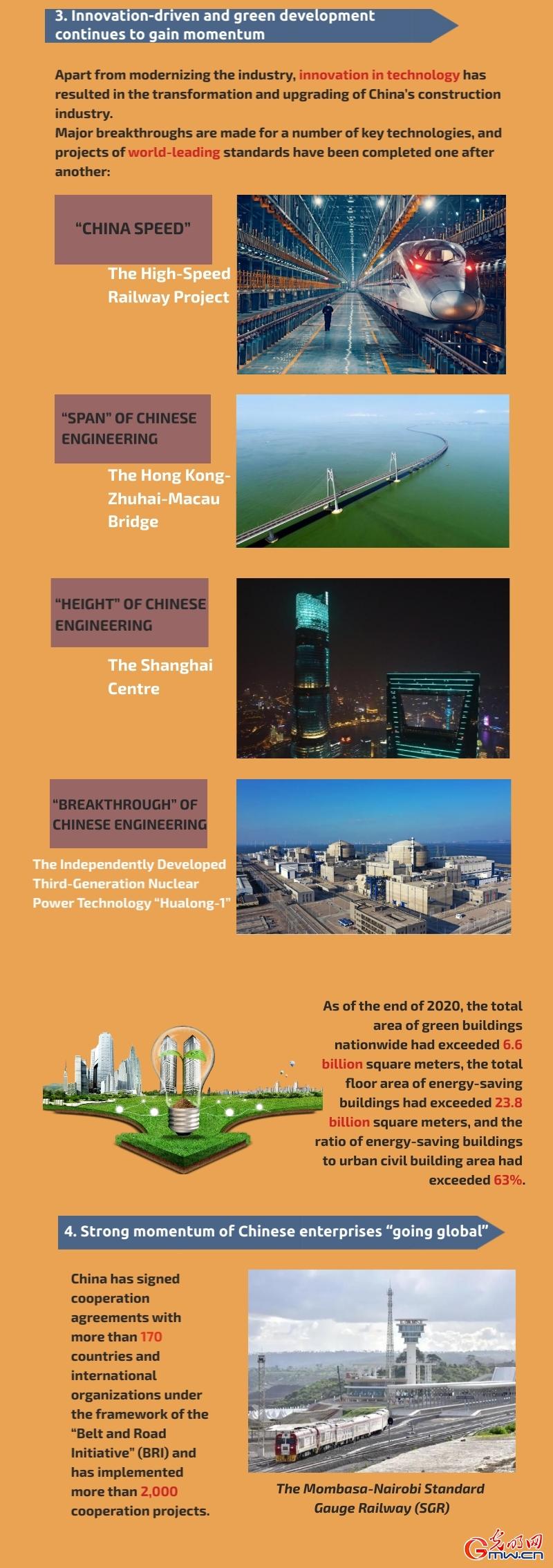
3. Innovation-driven and green development continues to gain momentum
Apart from modernizing the industry, innovation in technology has resulted in the transformation and upgrading of China’s construction industry. Major breakthroughs are made for a number of key technologies, and projects of world-leading standards have been completed one after another, such as the high-speed railway project showcasing the “China Speed”, and the Hong Kong-Zhuhai-Macau Bridge demonstrating the “span” of Chinese engineering, the Shanghai Centre building showing the “height” of Chinese engineering, and the independently developed third-generation nuclear power technology “Hualong-1” that represents the “breakthrough” of Chinese engineering.
China’s green buildings are developing rapidly and building renovations for energy efficiency purposes are being promoted in an orderly manner. According to the Ministry of Housing and Urban-Rural Development, as of the end of 2020, the total area of green buildings nationwide had exceeded 6.6 billion square meters, the total floor area of energy-saving buildings had exceeded 23.8 billion square meters, and the ratio of energy-saving buildings to urban civil building area had exceeded 63%.
4. Strong momentum of Chinese enterprises “going global”
China has signed cooperation agreements with more than 170 countries and international organizations under the framework of the “Belt and Road Initiative” (BRI) and has implemented more than 2,000 cooperation projects. After years of development and construction, the inter-connectivity network featuring “Six Corridors, Six Roads, Multiple Ports in Multiple Countries” had basically taken shape.
Chinese construction enterprises have built the China-Myanmar oil and gas pipeline, the Mohammed VI Bridge in Morocco, the Mombasa-Nairobi Standard Gauge Railway (SGR), the Stueng Trang-Krauch Chhmar Bridge over Mekong River in Cambodia, and the Karot Hydropower Plant in Pakistan. The brand of “China Construction” has taken a deep root in the international arena.
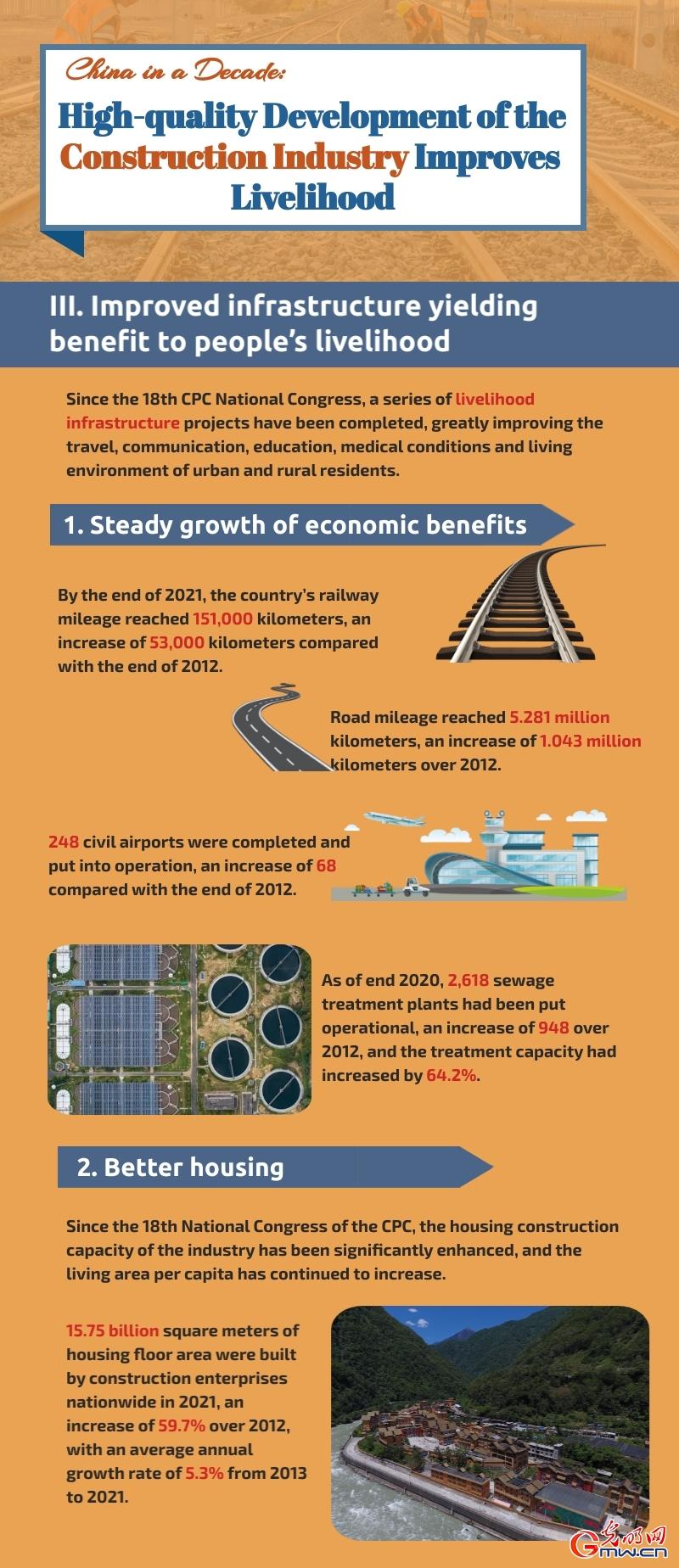
III. Improved infrastructure yielding benefit to people's livelihood
Since the 18th CPC National Congress, a series of livelihood infrastructure projects have been completed, greatly improving the travel, communication, education, medical conditions and living environment of urban and rural residents.
1. Better infrastructure
By the end of 2021, the country’s railway mileage reached 151,000 kilometers, an increase of 53,000 kilometers compared with the end of 2012; road mileage reached 5.281 million kilometers, an increase of 1.043 million kilometers over 2012; and 248 civil airports were completed and put into operation, an increase of 68 compared with the end of 2012.
A total of 1.007 million kilometers of urban water pipelines had been completed as of the end of 2020, an increase of 415,000 kilometers compared to the end of 2012.
851,000 km of natural gas pipelines were completed, an increase of 508,000 km; 803,000 km of drainage pipelines were deployed, an increase of 364,000 km.
As of end 2020, 2,618 sewage treatment plants had been put operational, an increase of 948 over 2012, and the treatment capacity had increased by 64.2%.
IT infrastructure has been widely promoted across the country, with 54.881 million kilometers of fiber-optic cable deployed nationwide as of 2021, an increase of 2.71 times over 2012; and 9.96 million mobile phone base stations were constructed, including 1.425 million 5G base stations as of 2021, and 5G networks have covered all cities and counties above the prefecture level.
2. Better housing
Since the 18th National Congress of the CPC, the housing construction capacity of the industry has been significantly enhanced, and the living area per capita has continued to increase. 15.75 billion square meters of housing floor area were built by construction enterprises nationwide in 2021, an increase of 59.7% over 2012, with an average annual growth rate of 5.3% from 2013 to 2021.
The housing floor area per urban resident increased from 32.9 square meters in 2012 to 41.0 square meters in 2021.
The renovation of shantytowns, urban villages and dilapidated houses has been steadily implemented, and urban renewal has been promoted in an orderly manner, too. From 2015-2021, more than 31 million units of various types of shantytowns were renovated nationwide, benefiting about 60 million residents. From 2019-2021, a total of 115,000 old urban districts were renovated, benefiting more than 20 million households.
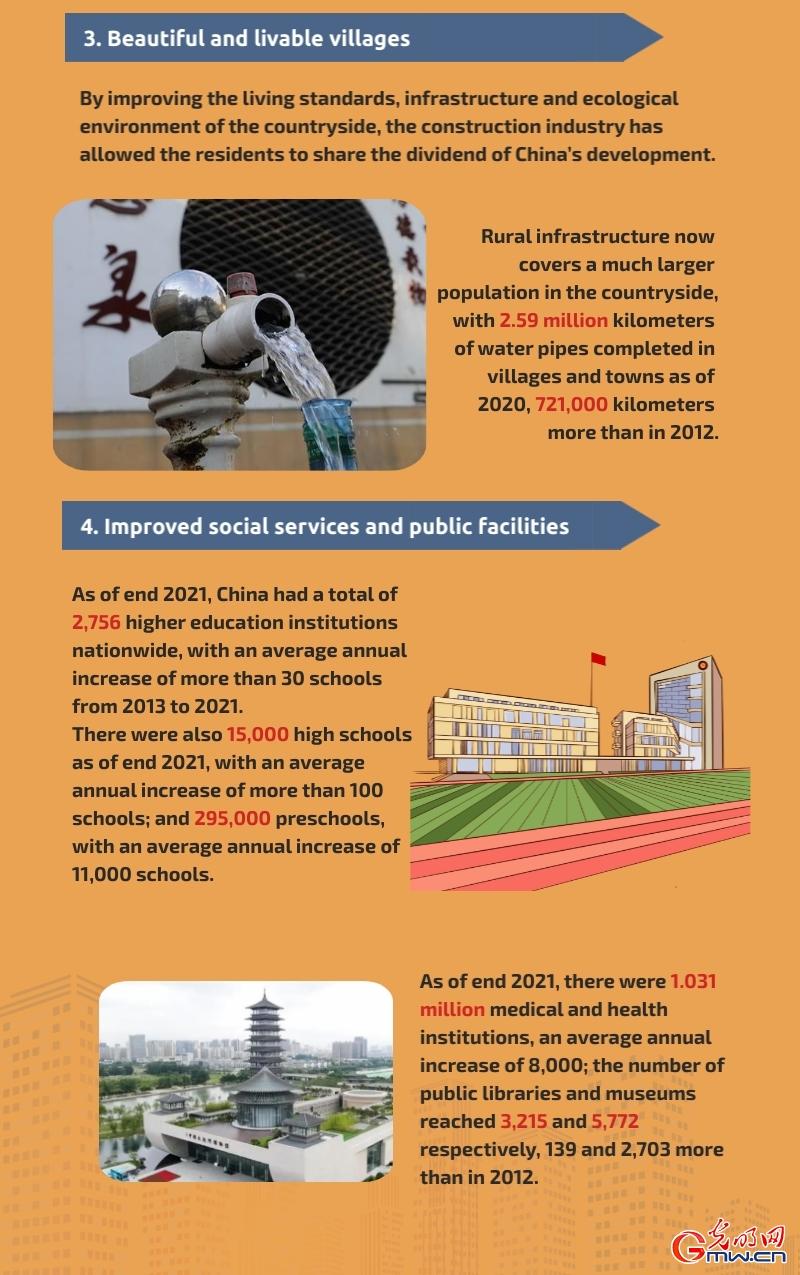
3. Beautiful and livable villages
By improving the living standards, infrastructure and ecological environment of the countryside, the construction industry has allowed the residents to share the dividend of China’s development.
Rural infrastructure now covers a much larger population in the countryside, with 2.59 million kilometers of water pipes completed in villages and towns as of 2020, 721,000 kilometers more than in 2012.
The treatment of rural domestic waste and sewage has been strengthened, with 222,000 kilometers of drainage pipes deployed as of 2020 at township and village levels, 75,000 kilometers more than in 2012.
At the same time, new progress has been made in information infrastructure in rural areas, with over 99% of villages connected to optical fiber and 4G network. All villages are now connected to broadband network, the Internet penetration rate at household level in rural areas has reached 57.6%.
4.Improved social services and public facilities
As of end 2021, China had a total of 2,756 higher education institutions nationwide, with an average annual increase of more than 30 schools from 2013 to 2021. There were also 15,000 high schools as of end 2021, with an average annual increase of more than 100 schools; and 295,000 preschools, with an average annual increase of 11,000 schools.
As of end 2021, there were 1.031 million medical and health institutions, an average annual increase of 8,000; the number of public libraries and museums reached 3,215 and 5,772 respectively, 139 and 2,703 more than in 2012.
(Source: National Bureau of Statistics)
Copyright © Xizang Daily & China Xizang News All rights reserved
Reproduction in whole or in part without permissions prohibited
Index Code: 藏 ICP 备 05000021 号
Producer: Xizang Daily International Communication Center